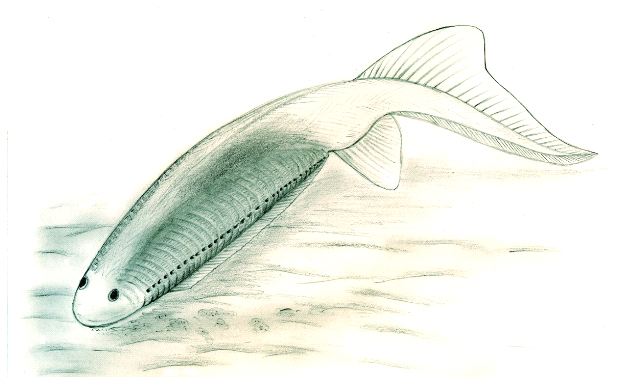Endeiolepis
About sixty specimens of Endeiolepis have been found in the Escuminac Formation, all extracted from a few sandstone layers within the same small area of the cliffs.

 (32 kb)
(32 kb)
Until very recently, Endeiolepis was described as being quite similar to Euphanerops, the main difference being a long series of elongated scales forming a ventrolateral protuberance on each side of Endeiolepis’ body. These structures were previously interpreted as the marks of ventral fins, similar to those found in some Silurian anaspid species.
But a recently discovered Endeiolepis specimen revealed an abdomen that split open as the fish decayed, making it possible to study the well-preserved details of these “scaly” ventral structures from the inside. It turns out that this feature was not related to fins after all; instead, it represents a series of small internal gill pouches, like those of today’s lamprey. But unlike the lamprey, which has seven pairs of gill pouches, Endeiolepis had about 30, as is also the case for Euphanerops. The finely preserved details in the recent Endeiolepis specimen also showed the outline of small gill lamellae.
This discovery is the oldest evidence of respiration through gill pouches. Once believed to be a specialization in existing lampreys and hagfishes, it now seems more probable that gill pouches were an ancestral condition of vertebrates, subsequently lost in the gnathostomes.
By discovering the true nature of the “scaly” ventral structure, however, we have effectively erased the one anatomical trait that distinguished Endeiolepis from Euphanerops! Could this mean that they are one and the same species, or at least very closely related? Palaeontologists now think that this is the case. Their apparent dissimilarity could simply be due to differences in the environments in which they were preserved. Indeed, we only find Endeiolepis in turbidite deposits made of sand, which promote three-dimensional preservation, and Euphanerops in thinly layered clay beds, which tend to flatten specimens.

 (32 kb)
(32 kb)Until very recently, Endeiolepis was described as being quite similar to Euphanerops, the main difference being a long series of elongated scales forming a ventrolateral protuberance on each side of Endeiolepis’ body. These structures were previously interpreted as the marks of ventral fins, similar to those found in some Silurian anaspid species.
But a recently discovered Endeiolepis specimen revealed an abdomen that split open as the fish decayed, making it possible to study the well-preserved details of these “scaly” ventral structures from the inside. It turns out that this feature was not related to fins after all; instead, it represents a series of small internal gill pouches, like those of today’s lamprey. But unlike the lamprey, which has seven pairs of gill pouches, Endeiolepis had about 30, as is also the case for Euphanerops. The finely preserved details in the recent Endeiolepis specimen also showed the outline of small gill lamellae.
This discovery is the oldest evidence of respiration through gill pouches. Once believed to be a specialization in existing lampreys and hagfishes, it now seems more probable that gill pouches were an ancestral condition of vertebrates, subsequently lost in the gnathostomes.
By discovering the true nature of the “scaly” ventral structure, however, we have effectively erased the one anatomical trait that distinguished Endeiolepis from Euphanerops! Could this mean that they are one and the same species, or at least very closely related? Palaeontologists now think that this is the case. Their apparent dissimilarity could simply be due to differences in the environments in which they were preserved. Indeed, we only find Endeiolepis in turbidite deposits made of sand, which promote three-dimensional preservation, and Euphanerops in thinly layered clay beds, which tend to flatten specimens.
Site map | Feedback | Links | Sources | Credits
Endeiolepis
<< Anaspids | Euphanerops >>



